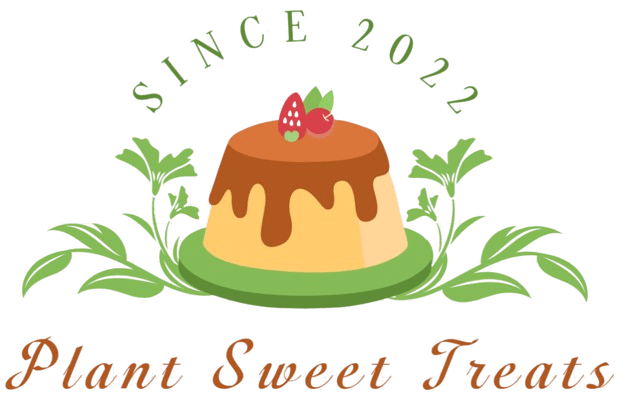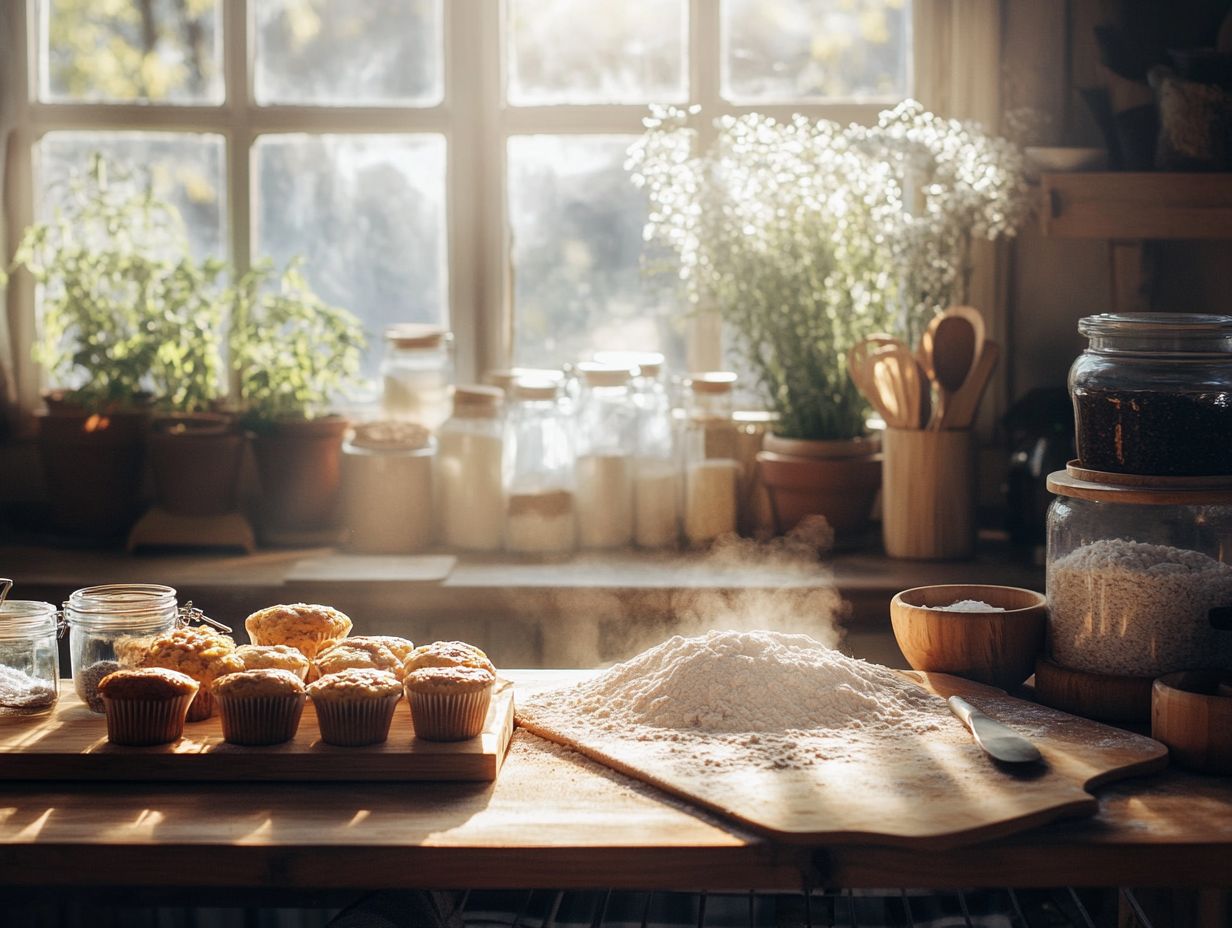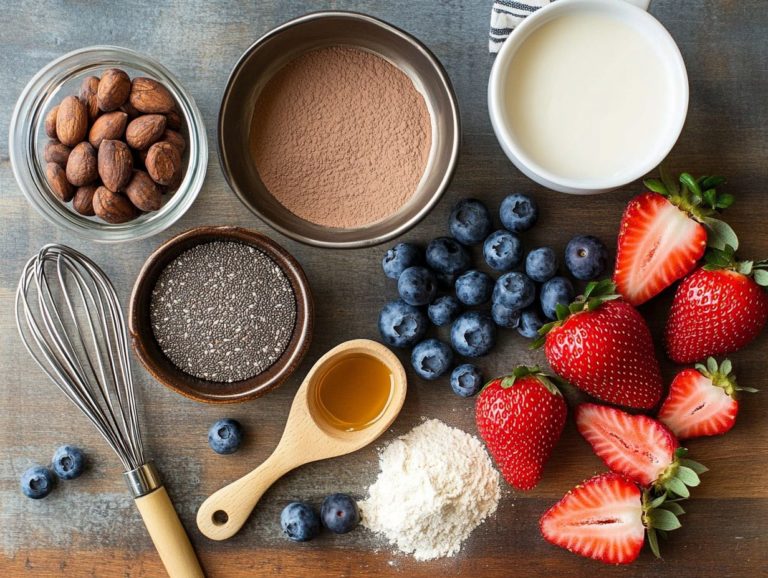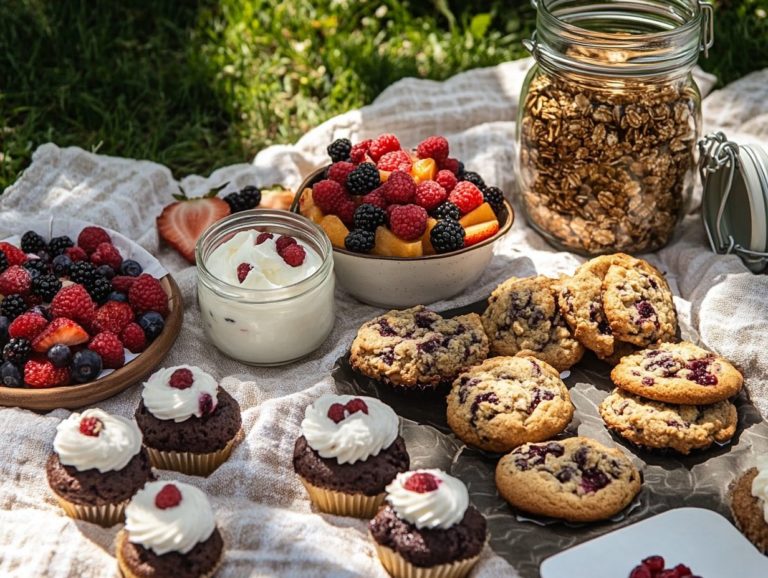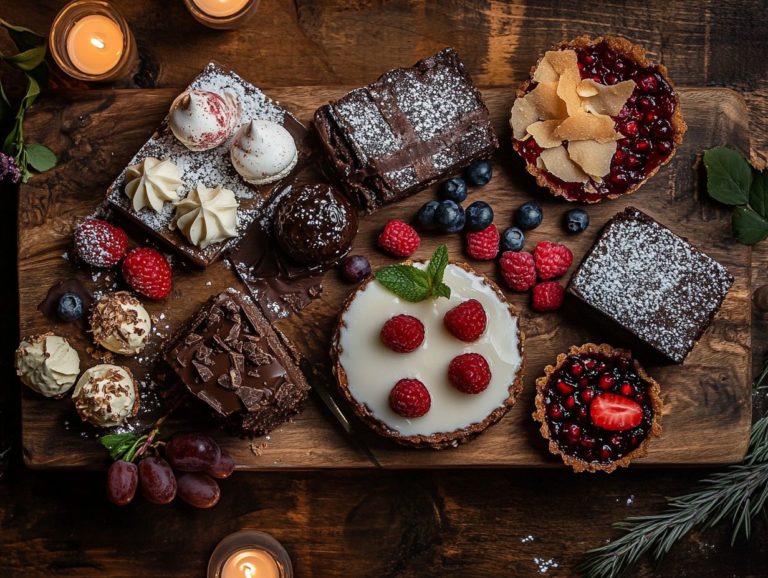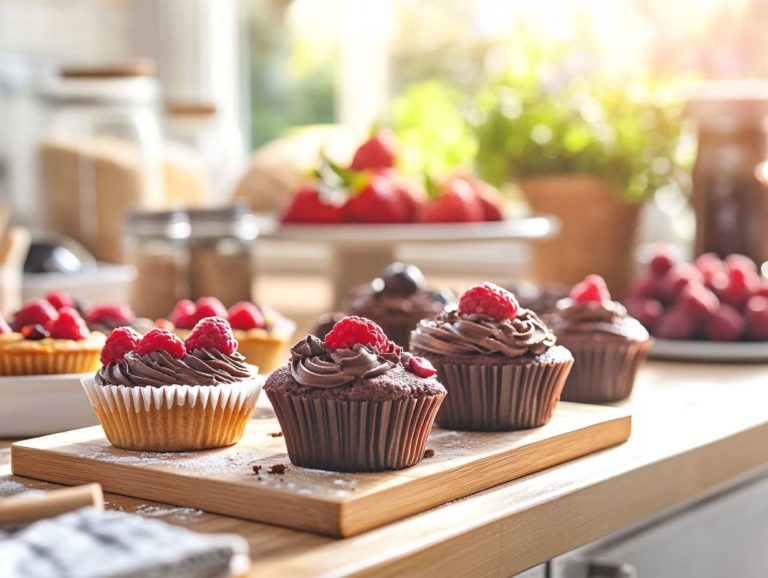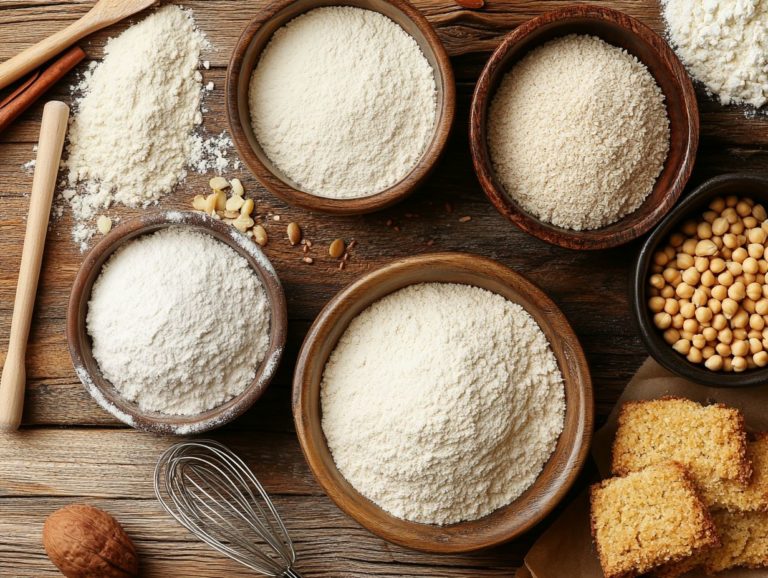Exploring the World of Gluten-Free Baking
Gluten-free baking has surged in popularity, reshaping how you approach your culinary creations, whether you re interested in vegan or dairy-free options.
Whether you’re managing gluten intolerance, celiac disease, allergies, or simply in search of healthier alternatives, a delightful world of recipes awaits your discovery.
This guide will illuminate the benefits of gluten-free baking, the essential ingredients you’ll need, and the challenges you may encounter along the way, including tips on avoiding cross-contact.
From mastering which flours to select to uncovering tips for achieving that perfect texture and flavor, you’ll be thoroughly prepared to embark on your gluten-free baking journey with confidence.
Contents
- Key Takeaways:
- Why Choose Gluten-Free Baking?
- What Ingredients are Used in Gluten-Free Baking?
- What are the Alternatives to Wheat Flour?
- What Other Ingredients are Used in Gluten-Free Baking?
- What are the Benefits of Gluten-Free Baking?
- What are the Challenges of Gluten-Free Baking?
- How to Get Started with Gluten-Free Baking?
- 1. Stock Up on Gluten-Free Ingredients
- 2. Experiment with Recipes
- 3. Learn from Others
- Tips and Tricks for Successful Gluten-Free Baking
- 1. Measure Accurately
- 2. Use Xanthan Gum or Guar Gum
- 3. Don’t Overmix
- Frequently Asked Questions
- What is gluten-free baking?
- Why would someone choose to explore the world of gluten-free baking?
- What ingredients are used in gluten-free baking?
- Are there specific techniques to follow when baking gluten-free?
- Is it possible to make delicious and tasty treats with gluten-free baking?
- Can I still use my favorite recipes for gluten-free baking?
Key Takeaways:
Why Choose Gluten-Free Baking?
Choosing gluten-free baking not only serves those with gluten intolerance or celiac disease but also invites you into a realm of culinary exploration and creativity. This journey opens up a treasure trove of healthy recipes, vegan ingredients, and alternative ingredients, enhancing your skills in the kitchen.
Over recent years, gluten-free baking has skyrocketed in popularity, inspiring both home bakers and professional chefs to dive into gluten-free options. This trend has given rise to a vibrant culinary language that celebrates diverse flavors and textures.
Embracing gluten-free baking can elevate your culinary experience, enabling you to craft nourishing and delectable meals that cater to a variety of dietary needs.
Who Can Benefit from Gluten-Free Baking?
You can significantly enhance your culinary experience by exploring gluten-free baking, especially if you have gluten intolerance or celiac disease. It allows you to enjoy delectable treats without the worry of adverse health effects.
If you follow specific dietary restrictions, such as dealing with autoimmune disorders or adhering to a paleo, ketogenic diet, or even a vegan diet, gluten-free options can also provide a welcome solution. It’s essential to understand gluten’s sneaky presence in many processed foods, particularly for those in vulnerable groups.
By recognizing the impact gluten can have on your well-being, you give the power to yourself to make informed choices when it comes to baked goods.
Embracing gluten-free alternatives means you can savor a diverse array of flavors while ensuring your dietary needs are fully met, transforming a previously challenging situation into a delightful and safe culinary adventure.
What Ingredients are Used in Gluten-Free Baking?
Gluten-free baking invites you to explore a remarkable variety of alternative ingredients that replace traditional wheat flour, all while preserving the beloved texture and flavor of your favorite baked goods.
As you embark on this gluten-free baking adventure, you’ll encounter an impressive selection of flours think buckwheat, brown rice, teff, and oat flour. Each one brings its own unique qualities to the table, enhancing your baking experience in delightful ways.
By mastering the art of combining these flours and incorporating starches like tapioca and potato starch, you can create scrumptious results that please both gluten-free enthusiasts and traditionalists alike.
What are the Alternatives to Wheat Flour?
When it comes to gluten-free baking, you have a multitude of nutrient-dense alternatives to wheat flour at your fingertips. Options like buckwheat, brown rice, teff flour, and oat flour each contribute their own unique flavors and textures to your creations.
Consider the characteristics these flours offer: buckwheat, with its rich, earthy flavor, shines in hearty pancakes or rustic bread. Meanwhile, brown rice flour has a mild taste that is perfect for crafting light, airy cakes.
Teff flour, celebrated for its slightly sweet and nutty flavor, works wonders in cookies and muffins. Oat flour brings a wholesome, subtly sweet profile ideal for cookies and granola bars.
Embracing a spirit of experimentation in your kitchen can lead to exciting combinations and new favorites, all while accommodating diverse dietary needs without compromising taste.
What Other Ingredients are Used in Gluten-Free Baking?
In your gluten-free baking endeavors, it’s essential to look beyond just flour alternatives. You’ll often need other key ingredients like tapioca starch, potato starch, xanthan gum, and psyllium husk to achieve that perfect consistency and texture, similar to those created by baking experts like Aran Goyoaga from Cannelle et Vanille.
These ingredients replicate the qualities of gluten, providing the elasticity and structure that traditional baked goods rely on. Tapioca starch and potato starch act as binding agents, ensuring everything stays nicely held together.
Meanwhile, xanthan gum is a thickener derived from bacteria that adds much-needed viscosity and stability, preventing your creations from crumbling apart. Psyllium husk not only helps retain moisture but enhances the chewiness of your final product.
For optimal results, consider combining these ingredients in the right ratios. A common tip is to start with a blend of starches and gradually incorporate xanthan gum. This method ensures even distribution throughout the mix, allowing for a beautifully uniform texture.
What are the Benefits of Gluten-Free Baking?
The benefits of gluten-free baking extend well beyond dietary restrictions, presenting you with health advantages, allergy-friendly options, and an expanded array of flavors and textures in your baked creations. Explore recipes from cookbooks like Brian Levy’s “Good & Sweet” to discover more.
By opting for gluten-free recipes, you can whip up delightful treats that appeal to a broader audience, including individuals with celiac disease and gluten intolerance. This journey allows you to explore new ingredients and flavor combinations, elevating your overall baking experience.
Jumping into gluten-free baking opens up a world of creativity and inclusivity. It leads to the discovery of unique recipes that cater to diverse tastes. Joining a community of gluten-free bakers can provide inspiration and support, enriching your baking journey.
1. Health Benefits
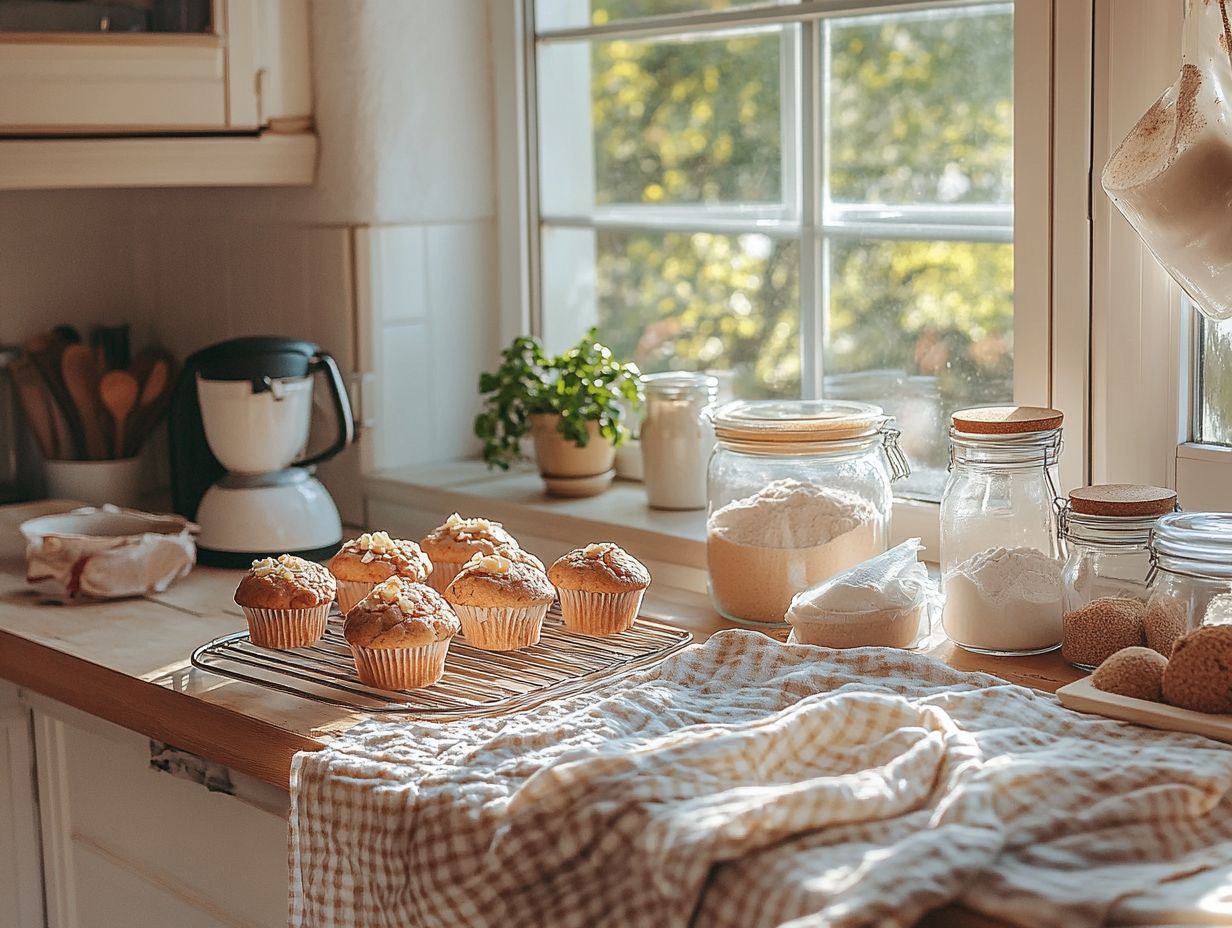
The health benefits of gluten-free baking are quite remarkable, especially for individuals with gluten intolerance or celiac disease. You may find that it enhances your digestive health while boosting your energy levels and reducing inflammation.
By choosing gluten-free grains such as quinoa, brown rice, or amaranth, you ll quickly feel the difference say goodbye to bloating and discomfort often linked to gluten consumption. These alternatives not only provide safety but also pack a wealth of nutrients, transforming your meals into nourishing experiences.
Picture this: a vibrant quinoa salad brimming with fresh vegetables and a zesty lemon vinaigrette makes for an excellent lunch choice, or perhaps a hearty gluten-free pumpkin bread for an afternoon treat.
Additionally, swapping out traditional flour for almond or coconut flour in your homemade baked goods can lead to delightful creations imagine savoring almond flour pancakes topped with fresh fruit or enjoying a slice of coconut flour cake.
For those diagnosed with gluten-related disorders, seeking guidance from healthcare professionals is essential. This ensures you maintain a balanced diet while navigating the world of gluten-free options with confidence.
2. Allergy-Friendly
Gluten-free baking offers a world of allergy-friendly options tailored for those with specific dietary restrictions. You can indulge in delicious treats without worrying about allergic reactions.
This commitment to inclusivity expands your culinary horizons if you or someone you know has celiac disease or gluten intolerance. It also sparks creativity in your kitchen. By experimenting with alternative ingredients like almond flour, coconut flour, and tapioca starch, you can whip up delightful recipes that are not only safe but surprisingly flavorful.
These thoughtful substitutions result in treats that appeal to a wider audience. This ensures that gatherings are more enjoyable for everyone. With a focus on gluten-free options, the culinary landscape transforms into an inviting space where everyone regardless of dietary needs can relish the joy of baked goods.
3. Increased Variety
One remarkable aspect of gluten-free baking is the incredible variety it offers. It challenges you to discover exciting new flavors and textures that you might not encounter in traditional baking. This includes experimenting with different types of bread such as sourdough or ciabatta, and even pastries like flan p tissier and tarts.
This journey of experimentation can lead to innovative recipes using alternative flours like almond, coconut, and chickpea. These ingredients enhance both nutritional value and taste. By embracing diverse ingredients, you can craft everything from light and airy artisan breads to rich and decadent desserts like brownies and cakes.
The absence of gluten encourages the inclusion of seeds, nuts, and fruits, resulting in unique flavor combinations that surprise and delight your palate. Ultimately, gluten-free baking meets dietary needs and opens up a world of cooking options, inspiring your creativity and passion in the kitchen, whether you’re baking vegan or dairy-free.
What are the Challenges of Gluten-Free Baking?
Even with numerous advantages, gluten-free baking presents unique challenges that you ll need to navigate. From sourcing the right ingredients to tweaking recipes and achieving that perfect texture and taste, the journey can feel overwhelming whether you re just starting out or have years of experience under your belt.
Understanding these challenges is essential, especially for those with celiac disease or gluten intolerance. Gluten-free ingredients often have their own quirks and behave quite differently than traditional wheat flour. That s why grasping these challenges and honing the right techniques is crucial for crafting delectable gluten-free treats that will delight everyone, regardless of their dietary preferences.
1. Finding the Right Ingredients
Finding the right ingredients for gluten-free baking can feel like a quest worthy of an epic tale. Not all gluten-free flours and substitutes deliver the same results in your culinary endeavors.
Understanding the unique characteristics of various gluten-free ingredients such as their texture, moisture retention, and binding properties is essential for achieving baking success. For instance, almond flour can add a rich flavor and moisture to your creations, while coconut flour tends to absorb more liquid, which might require a few tweaks to your recipe.
Exploring flours like teff flour, buckwheat, and oat flour can also provide diverse textures and flavors. To uncover quality gluten-free ingredients, consider wandering into specialized health food stores or farmers’ markets, where you can discover fresher, less processed options.
Take the time to read labels and select products that are certified gluten-free; this helps ensure better results while keeping your dietary needs in check. Ensuring food safety and avoiding cross-contact with gluten-containing products is also crucial.
By choosing the best ingredients tailored to each recipe, you not only elevate the taste but also enhance the texture and overall integrity of your baked goods. This can turn your meals into nourishing and delicious experiences.
Get started on your gluten-free baking adventure today!
2. Adjusting Recipes
Adjusting traditional recipes for gluten-free baking demands your careful attention to ingredient ratios and substitutions to ensure delightful outcomes. Utilizing alternative ingredients such as tapioca starch, potato starch, and cornmeal can help you achieve the desired results.
This process often entails swapping out all-purpose flour for gluten-free blends, which might include a combination of rice flour, almond flour, or coconut flour. Incorporating binding agents like xanthan gum or psyllium husk is important for keeping your baked goods intact, as they help mimic the elasticity that gluten provides. This elasticity is crucial for maintaining the integrity of your baked creations.
For instance, when converting a classic chocolate chip cookie recipe, simply replace the flour with a gluten-free mix and add a teaspoon of xanthan gum to provide the necessary structure.
You may also need to adjust baking times and temperatures, as gluten-free batters can behave differently often requiring slightly lower temperatures and longer durations for those optimal results. This is part of the gluten-free baking journey that many bakers undertake.
3. Texture and Taste Differences
One of the most significant challenges you ll encounter in gluten-free baking is achieving that perfect texture and taste, which can differ significantly from traditional baked goods. Gluten plays a vital role in providing structure, elasticity, and that satisfying chewiness, elements that are often missing in gluten-free alternatives. This may result in crumbly or dense baked goods, so it’s crucial for you to experiment with various flours and binding agents to replicate that familiar softness and rise.
For example, when you incorporate ingredients like almond flour or coconut flour, not only do you introduce unique flavor profiles, but you also enhance the moisture content of your baked goods. A splash of apple cider vinegar or a sprinkle of xanthan gum can work wonders, improving the overall elasticity of your dough.
To take your gluten-free creations to the next level, think about infusing flavors with spices or citrus zest. Don t shy away from exploring gluten-free grains like quinoa or buckwheat. These thoughtful adjustments can transform a gluten-free recipe into a delightful masterpiece, enticing even the most devoted traditionalists to savor your culinary innovations.
Using proofing baskets can aid in the fermentation of gluten-free sourdough and bread recipes.
How to Get Started with Gluten-Free Baking?
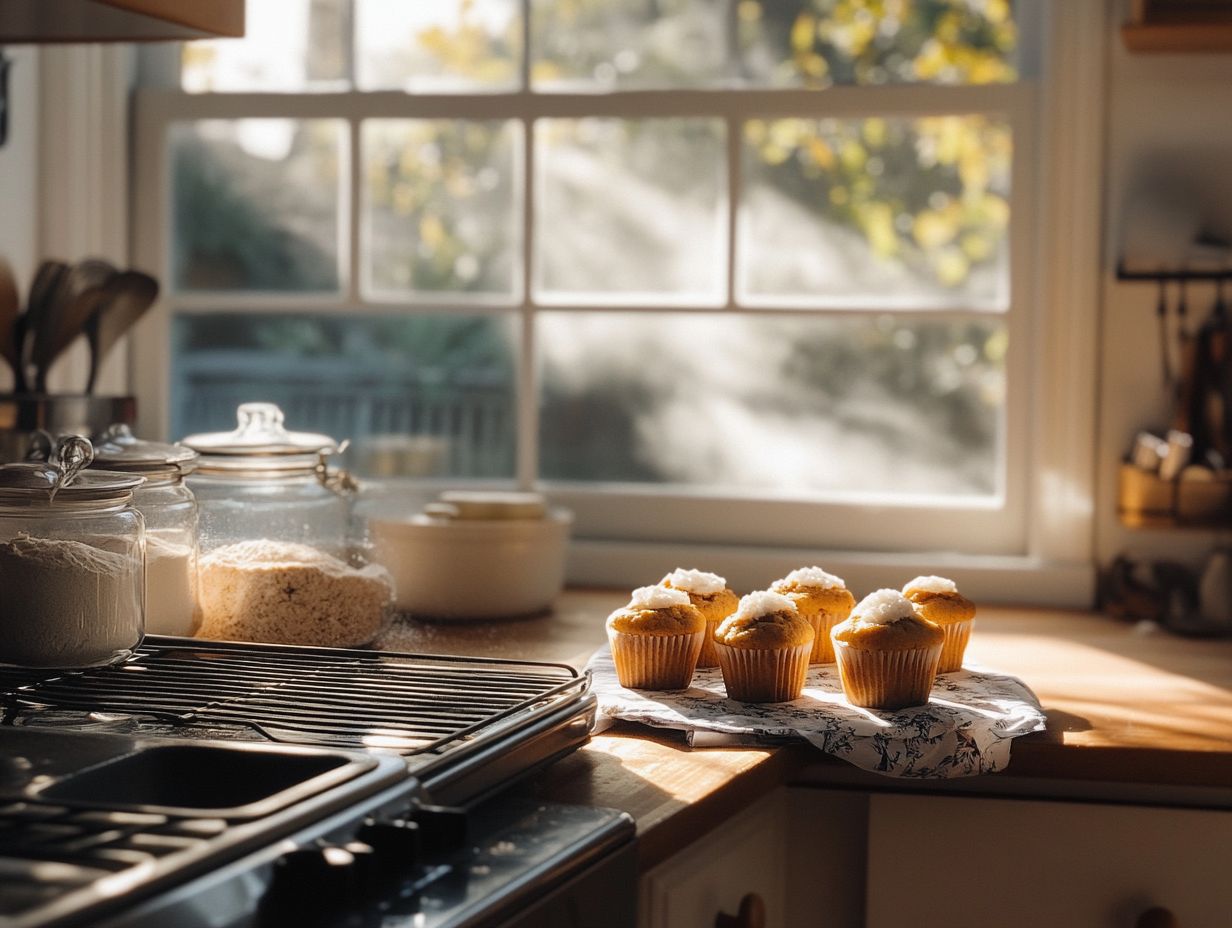
Start your exciting gluten-free baking adventure today! With the right mindset and preparation, you can create wonderful treats. Begin by gathering essential gluten-free ingredients and exploring a variety of recipes that align with your taste preferences. Refer to cookbooks like Cannelle et Vanille and Loopy Whisk for inspiration and guidance.
With some practice and a touch of experimentation, you ll soon be crafting nourishing and delectable treats that everyone can savor, no matter their dietary restrictions. Exploring flour combinations and ingredients like chickpea flour and rice flour can significantly enhance your baking.
1. Stock Up on Gluten-Free Ingredients
Before you embark on your gluten-free baking adventure, it’s crucial to gather a variety of gluten-free ingredients to ensure you have everything at your fingertips for crafting delightful recipes. This thoughtful preparation streamlines your cooking process and elevates the quality of your baked goods, turning your gluten-free journey into a truly rewarding experience.
By assembling a well-curated selection of essentials think almond flour, coconut flour, chickpea flour, and an array of starches like tapioca and arrowroot you’ll establish a solid foundation for your culinary creations. Make sure to include potato starch and tapioca starch as they are often key components.
Don t overlook the importance of integrating binding agents like xanthan gum and psyllium husk. They can significantly enhance the texture of your baked delights.
Investing in a kitchen scale helps you achieve precise measurements. This is key to consistent results in gluten-free baking.
2. Experiment with Recipes
Dive right into experimenting with gluten-free recipes! The flavors and textures will surprise you. By exploring a variety of gluten-free options from artisan bread to mouthwatering cakes and cookies you unlock a wealth of culinary possibilities that cater to various tastes and dietary requirements. Trying out different recipes like flatbread, pastry, and sourdough starter can provide a comprehensive learning experience.
You ll find it exhilarating to experiment with different flour combinations, such as almond, coconut, or chickpea flour, each adding its unique flair to your baked creations. If you’re just beginning your gluten-free journey, starting with simpler recipes can help you build confidence before diving into more complex endeavors.
This gradual approach sharpens your baking skills and sparks creativity in the kitchen, transforming the entire process into a delightful adventure.
3. Learn from Others
Learning from others within the gluten-free baking community offers you invaluable insights, tips, and inspiration that can elevate your baking journey to new heights.
By engaging with these online communities, you ll find a wealth of knowledge that you simply won t find in traditional cookbooks or cooking classes. Attending workshops led by seasoned bakers provides you with hands-on learning opportunities, allowing you to practice new techniques and ask questions in real-time. You may also find baking columns in food magazines to be a rich resource of baking tips.
Following expert bakers like Kat and Aran exposes you to a diverse array of recipes while encouraging the sharing of personal baking stories and challenges. This supportive environment fosters a sense of camaraderie, where you and your fellow bakers cheer each other on, exchange innovative recipe ideas, and celebrate your successes together. The gluten-free baking experience becomes not just a task, but a rich and fulfilling journey.
Tips and Tricks for Successful Gluten-Free Baking
To achieve remarkable success in gluten-free baking, you can employ specific tips and tricks that will significantly enhance your results and elevate your overall baking experience. Exploring alternative baking methods and vegan ingredients can also add variety to your creations.
1. Measure Accurately
Accurate measurement is essential in gluten-free baking. The right ingredient ratios can profoundly influence your final product.
Using a proofing basket can help achieve perfect artisan bread.
In gluten-free recipes, even minor deviations in measurement can lead to textures or flavors that fall short of expectations.
A kitchen scale is a critical tool in your baking arsenal.
Precision is vital given the diverse properties of gluten-free flours, which absorb moisture differently than traditional wheat flour.
For example, tapioca starch and potato starch each have unique absorption rates.
Weigh dry ingredients like almond flour or tapioca starch to ensure your quantities are accurate.
Consulting a cookbook can provide additional insights into precise measurements.
For liquids like oils or milk, using a scale removes guesswork.
This practice encourages consistency and elevates the overall quality of your gluten-free creations.
Precision is particularly important for bread and pastry recipes that require exact moisture levels.
2. Use Xanthan Gum or Guar Gum
Xanthan gum or guar gum is crucial for achieving the perfect texture and structure in gluten-free baking.
These ingredients effectively mimic the properties of gluten.
They are essential in creating sourdough and ciabatta with the right chewiness and elasticity.
These ingredients act as binding agents, providing elasticity that many gluten-free flours lack.
For chewy baked goods like cookies and muffins, add about 1 teaspoon per cup of flour.
For lighter textures, such as cakes or pancakes, use 1/2 teaspoon per cup of flour for guar gum.
Consider using teff flour and buckwheat for unique flavors.
Your choice between xanthan gum and guar gum can depend on personal preference or dietary considerations.
Experimenting with various alternative ingredients like oat flour, brown rice flour, and cornmeal can elevate the quality of your gluten-free treats.
3. Don’t Overmix
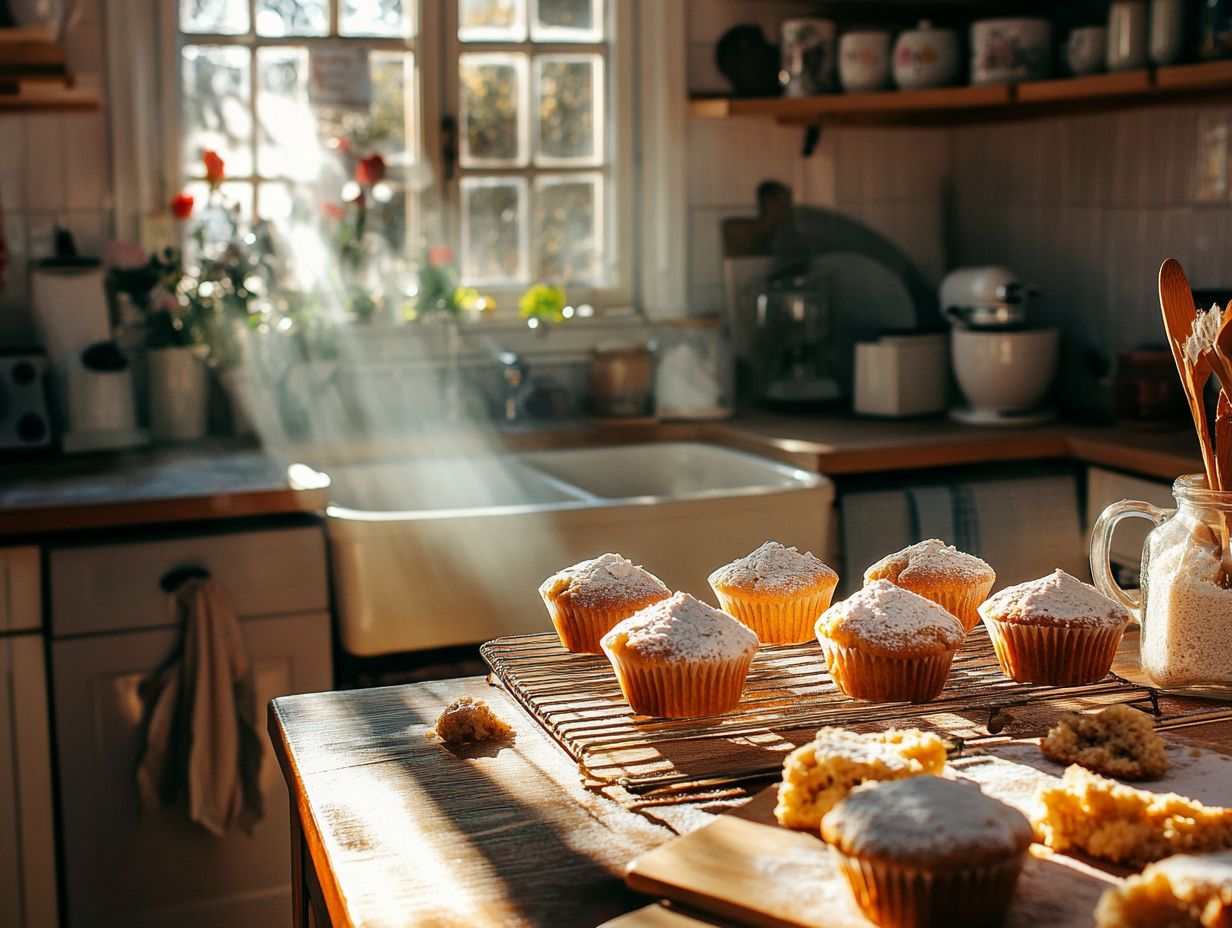
Managing the mixing process is vital in your gluten-free baking journey.
Avoid overmixing to prevent dense, unappealing textures in your baked treats.
Without gluten, the usual structure providing elasticity is missing; handle your batter with care.
Accurate measurements using a kitchen scale can help prevent mishaps.
Overmixing introduces excessive air, disrupting the delicate structure that gluten-free flours depend on.
This can lead to a heavy, gummy result.
Your goal is to make each baking experience enjoyable and successful.
To achieve a sought-after light and airy texture, gently fold the ingredients instead of vigorously beating the batter.
Using a spatula or wooden spoon allows for a soft mixing motion.
Tools like a proofing basket or a sourdough starter can enhance your gluten-free creations.
Mix just until combined, and consider letting the batter rest briefly to encourage a better rise and texture.
4. Let Baked Goods Cool Completely
Allowing your gluten-free baked goods to cool completely before slicing or serving is essential for achieving the ideal texture and flavor. This practice is especially important for gluten-free breads and pastries. It holds particular significance because gluten-free recipes often utilize alternative flours that behave quite differently from traditional wheat flour. By giving your creations sufficient time to cool, you allow the inner texture of the baked goods, known as the crumb structure, to set properly, which enhances moisture retention and prevents unwanted crumbling.
Regarding cookies, letting them rest on the baking sheet for a few minutes before transferring them to a wire rack is a key step. This simple act helps maintain their shape and softness. Cakes, on the other hand, benefit from a more extended cooling period in the pan about ten to fifteen minutes to solidify before being turned out. Muffins and quick breads should also be allowed to cool in their pans for a bit, ensuring they release easily without falling apart.
By adhering to these cooling techniques, you improve the overall quality of your baked goods. These tips will make a huge difference, especially when dealing with artisan gluten-free baking.
For more gluten-free baking tips and recipes, be sure to check out experts like Aran Goyoaga from Cannelle et Vanille and Kat from The Loopy Whisk.
Frequently Asked Questions
What is gluten-free baking?
Gluten-free baking is the process of making baked goods without using ingredients that contain gluten, a protein found in wheat, barley, and rye.
Why would someone choose to explore the world of gluten-free baking?
Exploring gluten-free baking can be a journey into new culinary techniques and flavors, enriched by using vegan and dairy-free ingredients. People with gluten intolerance or celiac disease may need to follow a gluten-free diet, making gluten-free baking a necessity. Others may choose to explore it for dietary reasons or simply for a change in their baking routine.
What ingredients are used in gluten-free baking?
In the world of gluten-free baking, alternative ingredients like sorghum flour and quinoa flour play a crucial role. Flours made from gluten-free grains such as rice, corn, almond, and coconut are commonly used in gluten-free baking. Other ingredients like tapioca starch, xanthan gum, and potato starch may also be utilized to improve texture and binding in baked goods.
Are there specific techniques to follow when baking gluten-free?
Using proper techniques ensures your gluten-free creations, from flatbread to artisan loaves, are successful. Gluten-free baking requires different techniques than traditional baking. For example, mixing the batter longer, using more leavening agents, and allowing the batter to rest before baking can all help achieve better results.
Is it possible to make delicious and tasty treats with gluten-free baking?
Absolutely! With the right ingredients and techniques, gluten-free baking can produce delicious and flavorful treats just like traditional baking. It may take some trial and error, but the end results can be just as satisfying.
Can I still use my favorite recipes for gluten-free baking?
Join a community of gluten-free bakers who share tips and adjustments. This way, you can easily adapt your favorite recipes and enjoy gluten-free baking together! In most cases, yes, but it may require some adjustments. Replacing wheat flour with a gluten-free alternative and adding more leavening agents can help achieve similar results. However, some recipes may need to be modified more significantly to work with gluten-free ingredients.
